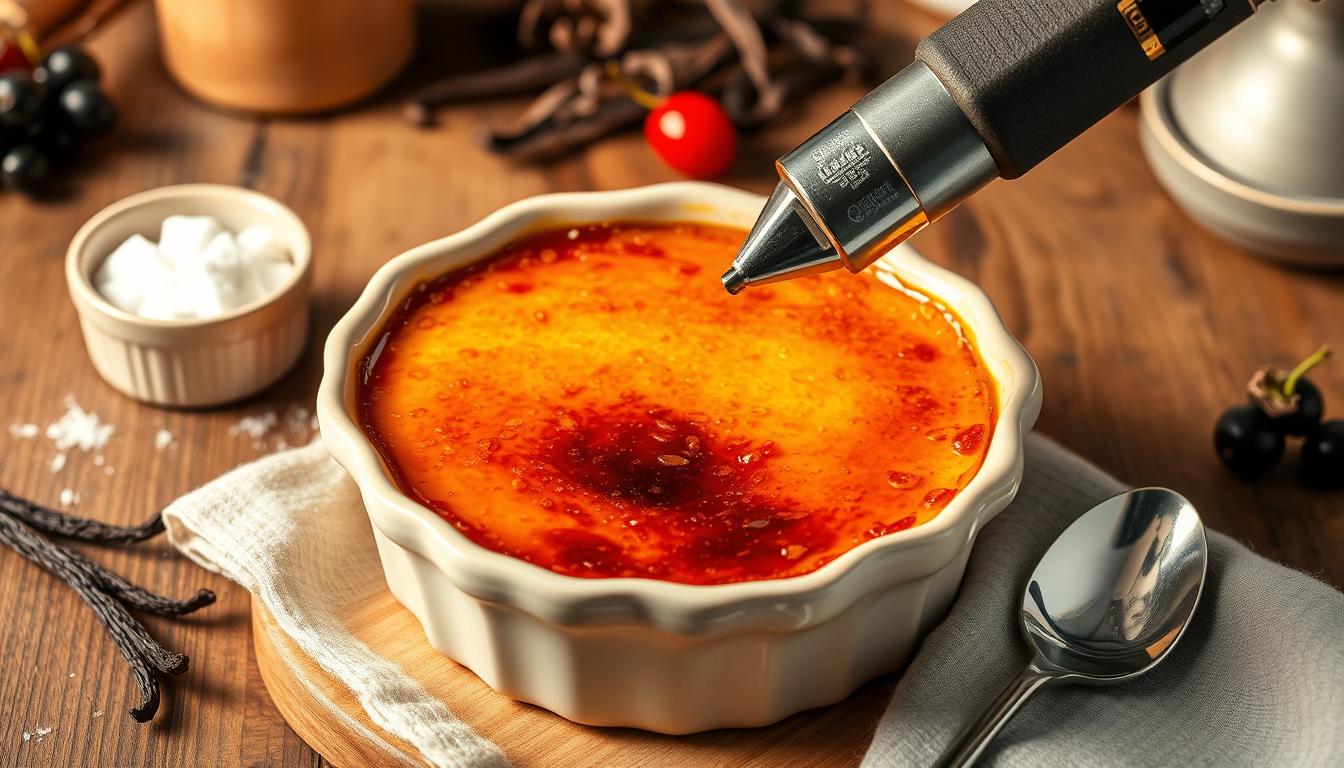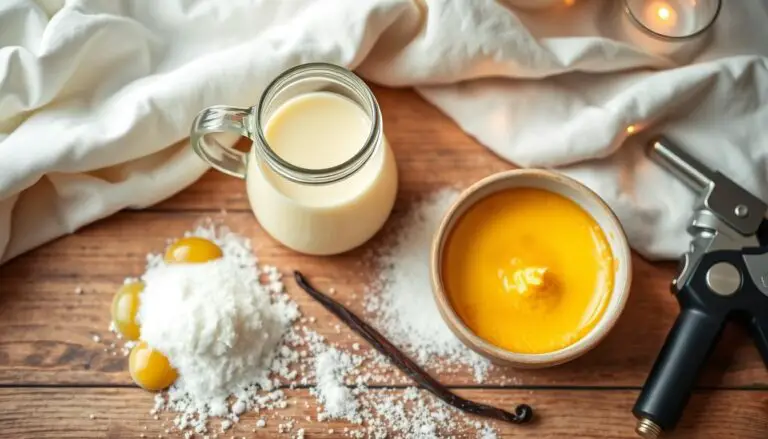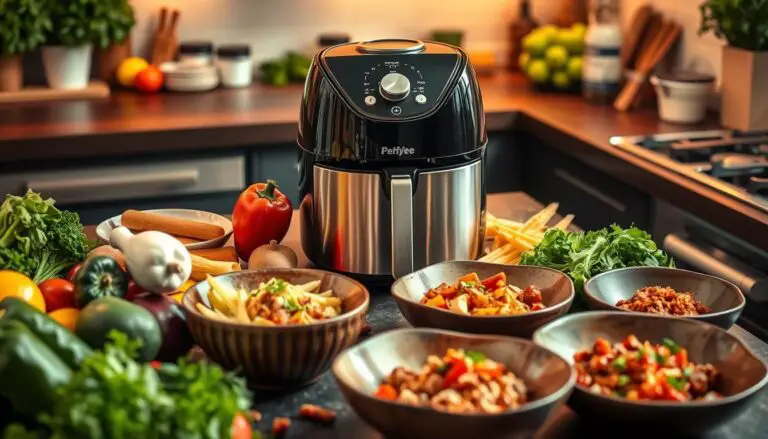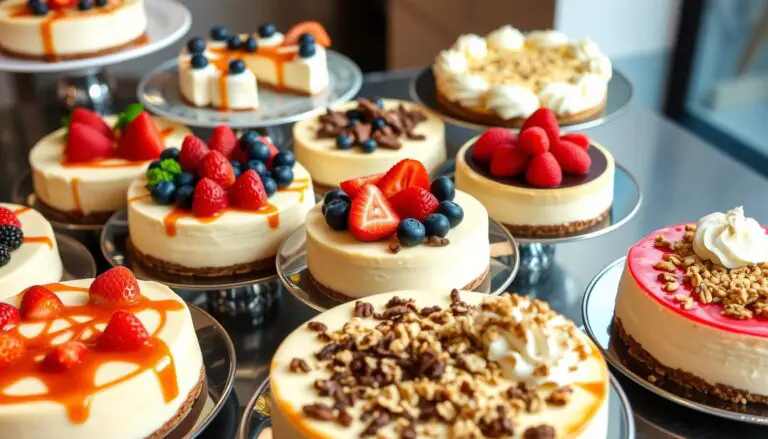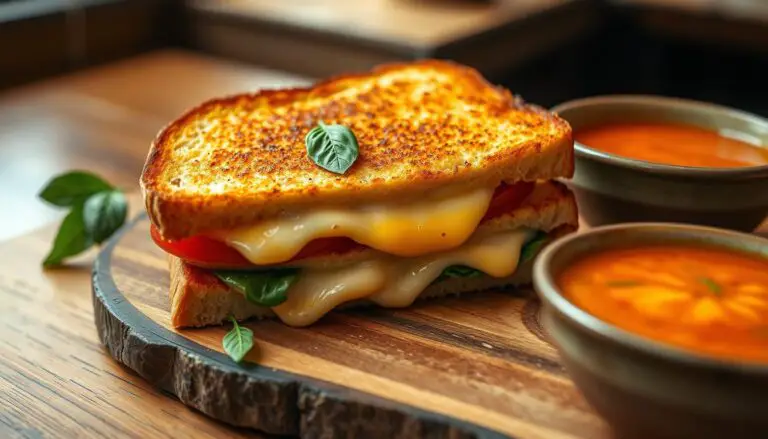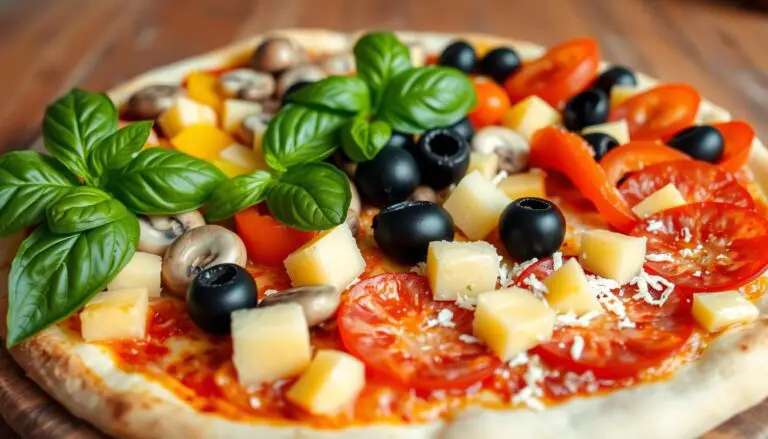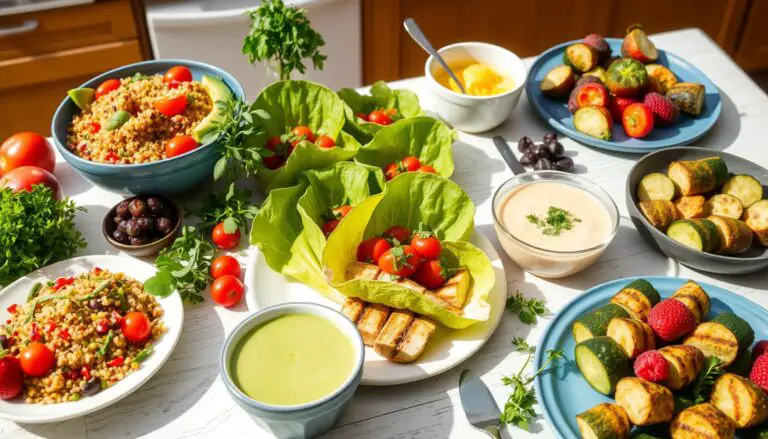Perfect Crème Brûlée Caramelizing Tips
Learning to caramelize crème brûlée can take your dessert game to the next level. The ideal crème brûlée has a smooth custard base and a crunchy, caramelized sugar top. This article will show you how to make your brûlée perfect, from the basics to advanced techniques.
We’ll cover everything from the dessert’s history to different ways to caramelize. Each part is aimed at improving your cooking skills and confidence.
Let’s dive into the details of making a flawless dessert that will wow your guests. For more detailed tips and complete instructions, check out this guide. It covers everything you need to know about making crème brûlée and caramelizing it perfectly.
Key Takeaways
- Understanding the importance of a silky custard base.
- Choosing the right sugar for a perfect caramelized topping.
- Essential tools like kitchen torches for achieving the best results.
- Common mistakes to avoid during the caramelization process.
- Alternative methods to caramelize if you lack traditional tools.
Understanding Crème Brûlée
Crème brûlée is a classic dessert with a rich history. It has evolved through culinary traditions. It’s loved for its creamy texture and crispy sugar crust.
History of Crème Brûlée
The history of dessert goes back to the 17th century in France. It was first mentioned in culinary texts. Legends say it has ties to Spanish and English recipes, but the French version won out.
Over time, the recipe has been adapted and refined. Yet, its essence remains the same. It’s about finding a balance between simplicity and sophistication.
Basic Ingredients of Crème Brûlée
To make the perfect crème brûlée, you need to know the basic ingredients. The main components are:
- Heavy cream: It gives the dessert a rich and smooth base.
- Egg yolks: They add creaminess and structure.
- Sugar: It balances sweetness and caramelizes to create the crust.
- Vanilla: It enhances flavor with its aromatic essence.
Each ingredient is crucial for achieving the dessert’s signature flavor and texture.
Essential Culinary Techniques
Making a perfect crème brûlée needs certain cooking skills, especially in making the custard. Knowing how to temper egg yolks and pick the best ingredients makes a big difference. This knowledge helps create a smooth, creamy dessert full of flavor.
Preparing the Custard
The custard is the core of crème brûlée. Begin by warming the cream to add flavors like fresh vanilla. Mix the egg yolks with sugar to make a thick base. To avoid lumps, slowly add warm cream to the egg yolks while whisking.
Choosing the Right Ingredients
Choosing top-notch ingredients is key. For crème brûlée, look for:
- Fresh vanilla beans for a strong taste.
- Organic eggs for extra richness.
- Heavy cream for a creamy texture.
Using the best ingredients boosts the flavor and adds elegance to the dish. This careful choice is part of the detailed cooking techniques needed for a beautiful dessert.
| Ingredient | Quality Indicator | Usage |
|---|---|---|
| Vanilla Beans | Dark, plump pods with a strong fragrance | Infuse in heated cream |
| Egg Yolks | Bright yellow color | Create rich custard |
| Heavy Cream | Thick consistency | Base for custard |
How to Caramelize Brulee?
Caramelizing the sugar topping on crème brûlée is an art that can make your dessert gourmet. It’s all about getting that perfect golden crust. The key is using a kitchen torch for an even melt, blending creamy custard with crunchy top.
Step-by-Step Caramelizing Process
To start the caramelizing process, follow these steps:
- Ensure the crème brûlée custard is thoroughly chilled. This step is crucial as it prevents the custard from heating up too quickly during caramelization.
- Sprinkle a thin, even layer of granulated sugar across the surface of the custard. Avoid clumping, as thick sugar layers can burn faster.
- Using a kitchen torch, caramelize the sugar by applying heat evenly across the surface. Keep the flame moving to avoid concentrating heat in one area, which could lead to burning.
- Watch for the sugar to melt and turn a deep amber color. This transformation indicates that the sugar is caramelizing correctly.
- Allow the caramelized sugar to cool for a few minutes before serving, as this will help form the desired crunchy layer.
Common Mistakes to Avoid
While learning how to caramelize brulee, be mindful of common mistakes in caramelizing that can lead to unsatisfactory results:
- Using powdered sugar instead of granulated sugar can produce an undesirable texture and uneven caramelization.
- Applying too much heat too quickly can result in burnt sugar. It is essential to control the flame during the process.
- Neglecting to chill the custard adequately before caramelization can lead to a warmed custard that disrupts the final texture.
- Skipping the cooling phase after caramelization can cause the layer to be too hot and sticky, instead of effectively crunchy.
For more details on perfecting your crème brûlée, you can visit this guide.
Choosing the Perfect Kitchen Torch
Creating crème brûlée is a delightful journey, and the right kitchen torch makes it even better. Knowing how to use a torch is key for that perfect caramelized sugar topping. When picking a torch for crème brûlée, there are important factors to consider.
First, think about the flame adjustment. A torch that lets you control the flame well helps you caramelize sugar evenly. The type of fuel is also important; butane torches are popular for their ease of use. Plus, features like an auto-lock mechanism can make cooking safer.
Here’s a look at some top kitchen torches to help you find the best for desserts:
| Brand | Fuel Type | Flame Adjustment | Safety Features | User Rating |
|---|---|---|---|---|
| Bernzomatic TS8000 | Butane | Adjustable | Locking Trigger | 4.7/5 |
| iSi North America | Butane | Adjustable | Safety Lock | 4.5/5 |
| Amtast Culinary Torch | Butane | Adjustable | Flame Guard | 4.6/5 |
Choosing the right torch is not just for crème brûlée. It opens up new possibilities in baking. With practice and the right tools, making a perfectly caramelized dessert will become easy.
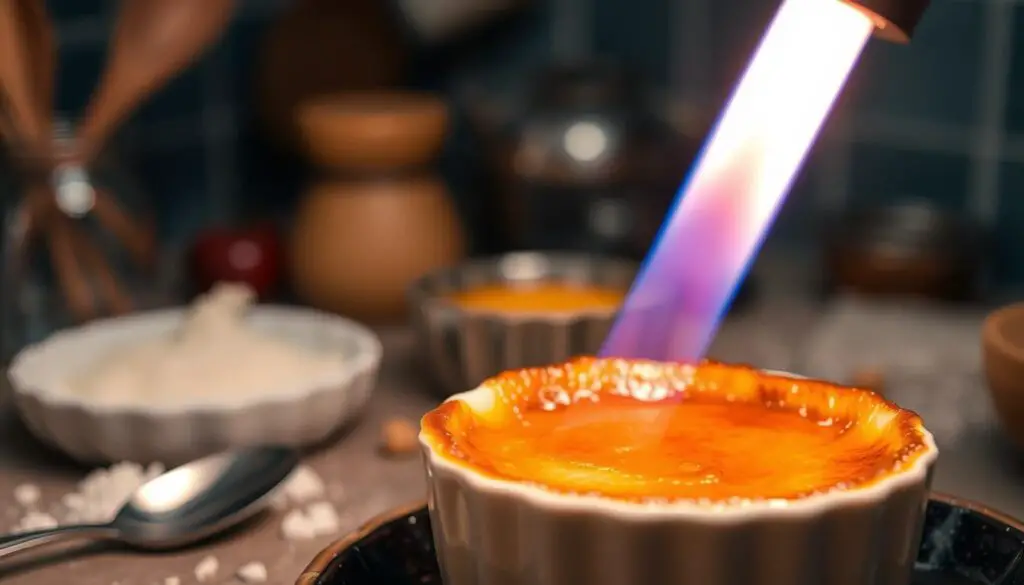
Alternative Methods for Caramelizing Sugar
Caramelizing sugar makes desserts like crème brûlée extra special. If you don’t have a kitchen torch, don’t worry. You can use an oven broiler or stovetop methods instead.
Using an Oven Broiler
Using the oven broiler is a simple way to get a nice burnt sugar topping. Here’s how to do it:
- Preheat your oven’s broiler to high.
- Spread an even layer of granulated sugar over the custard surface.
- Place the ramekin on the top rack, about 6 inches from the broiler’s heat.
- Watch as the sugar melts and turns golden brown. This usually takes 2-5 minutes.
- When it’s caramelized to your liking, take it out of the oven. Let it cool for a bit.
Stovetop Caramelization Techniques
Stovetop methods let you control the caramelization process. Here’s how to do it:
- Pour sugar into a heavy-bottomed skillet over medium heat.
- Stir gently until the sugar starts to melt.
- Keep a close eye on it to avoid burning. Stir until it turns golden.
- Pour the hot caramel over the custard for even coverage.
Both oven broiler caramelization and stovetop techniques need careful watching to get the perfect golden crust. Try these methods to see which one you like best.
| Method | Setup Time | Cooking Time | Direct Control |
|---|---|---|---|
| Oven Broiler | 5 minutes | 2-5 minutes | No |
| Stovetop Technique | 2 minutes | 5-10 minutes | Yes |
Baking Tips for a Perfect Crème Brûlée
To make the perfect crème brûlée, you need to focus on a few key things. Temperature control and the water bath method are crucial. These steps help you get a smooth, creamy custard, which is what makes this dessert so special.
Temperature Control
Keeping the temperature right is key to avoid overcooking or curdling the custard. Baking at a steady temperature is important. An oven thermometer helps you get the temperature just right. A gentle heat makes the custard velvety.
Try to bake at around 325°F for the best results.
Water Bath Method
The water bath method, or bain marie, is essential for baking crème brûlée. It involves placing ramekins in a dish of hot water. This method spreads heat evenly, preventing direct oven heat from affecting the custard.
The water should be hot but not boiling. This gentle heat ensures the custard cooks slowly and evenly. Using this method correctly will give you a creamy custard that’s perfectly set.
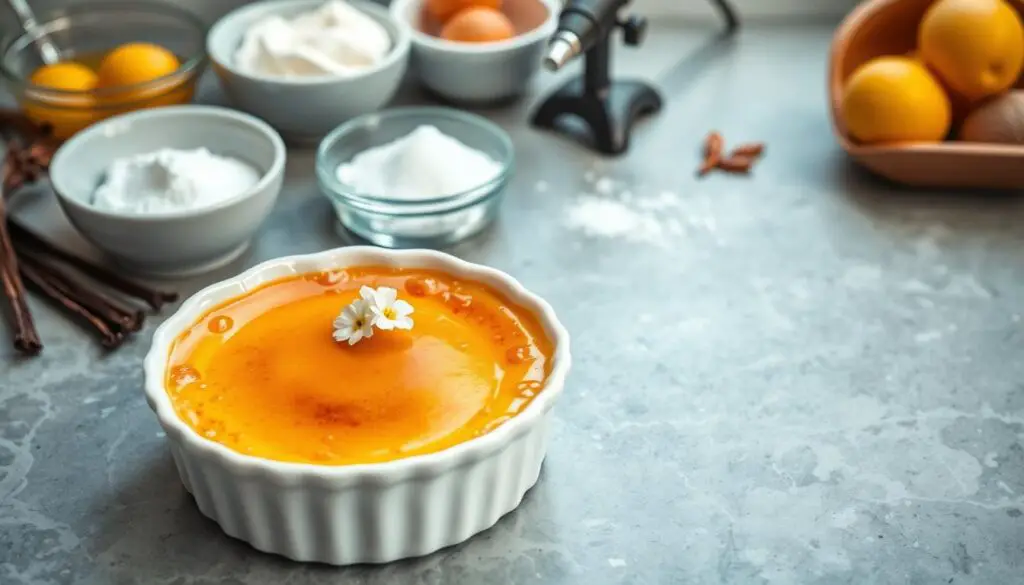
| Technique | Benefits | Considerations |
|---|---|---|
| Temperature Control | Prevents curdling and ensures consistent texture | Use an oven thermometer for accuracy |
| Water Bath Method | Ensures even heating and creamy custard | Avoid boiling water; use hot water instead |
Creating a Caramelized Sugar Topping
The perfect crème brûlée has a delicious caramelized sugar topping. To make this layer, you need to pick the right sugar and add flavors. Knowing about sugar and how it melts can make your dessert better.
Different Sugar Types to Use
Choosing the right sugar is key for a great caramelization. Here are some good options:
| Type of Sugar | Characteristics | Best Use |
|---|---|---|
| Granulated Sugar | Commonly used, melts easily, and caramelizes quickly. | Ideal for a traditional crust with a rich flavor. |
| Brown Sugar | Contains molasses, providing a deeper flavor and a moister texture. | Perfect for adding a caramel note to your topping. |
| Turbinado Sugar | Raw sugar with larger crystals, giving a crunchy texture. | Great for a distinct caramelized layer that adds visual appeal. |
Flavoring Your Crust
Adding flavor to your caramelized sugar topping can take your dessert to the next level. Here are some ways to flavor your desserts:
- Citrus Zest: Adding lemon or orange zest gives a refreshing zing.
- Spices: Cinnamon or nutmeg add warmth and excitement.
- Extracts: Vanilla or almond extract adds a sophisticated touch.
Serving Recommendations for Crème Brûlée
When serving crème brûlée, think about pairing it with other desserts and how to present it. This custard is special with its creamy inside and caramel top. It gets even better with the right sides and presentation. Here are some ideas for serving this classic dessert.
Pairing with Other Desserts
Choosing the right desserts to pair with crème brûlée can make your meal better. Here are some suggestions:
- Citrus Sorbet: A lemon or lime sorbet cleanses your palate.
- Fresh Berries: Add a splash of color with strawberries, raspberries, or blueberries.
- Chocolate Fondant: A warm chocolate dessert pairs well with crème brûlée’s creaminess.
- Cheese Platter: Mild, creamy cheeses offer a nice contrast to the sweet dessert.
Presentation Techniques
How you present desserts is key to the dining experience. For crème brûlée, try these presentation ideas:
- Elegant Ramekins: Use fancy ramekins to make the dish look better.
- Garnishing: Add a sprig of mint, edible flowers, or powdered sugar for a touch of elegance.
- Serve with a Sauce: Drizzle caramel or chocolate sauce for a fancy look.
- Use of Color: Mix colorful fruits or sauces with the custard for a pop of color.
French Cuisine and Crème Brûlée
Crème brûlée is a key part of French cuisine, linking food and culture deeply. It shows off the fine techniques and rich tastes of classic French cooking. This makes it a symbol of elegance among desserts.
Cultural Significance of the Dessert
Crème brûlée is more than just a tasty treat. It’s an art form that shows the history of French desserts. It’s often served in fancy places, making it a sign of joy and luxury.
From old banquets to today’s meals, crème brûlée captures the heart of French cooking. Its fame worldwide shows its lasting appeal and the charm of French food.
Crème brûlée lets people taste a bit of French culture. It’s more than a dessert; it’s a doorway to French food’s rich history. Every bite tells a story of love and hard work in cooking, making it a beloved sweet treat.
Conclusion
We’ve learned key techniques and tips for mastering crème brûlée. This journey covers the dessert’s history, essential ingredients, and how to get that perfect caramelized sugar crust. Each step is crucial for achieving dessert mastery.
As you try different ways to caramelize sugar and experiment with flavors, remember the final tips. Let your creativity show by making your own unique crème brûlée. Every attempt, whether it succeeds or not, helps you get better.
With time and effort, making crème brûlée becomes more than just cooking. It’s a way to express your culinary skills. So, get your ingredients ready, invite friends, and start this tasty journey. Your perfectly caramelized crème brûlée is waiting for you!

